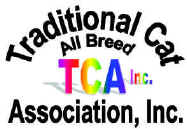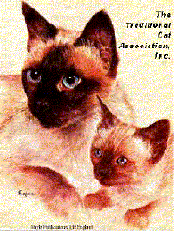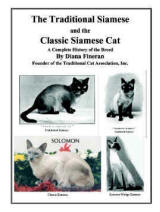|
SAVING FADING KITTENS
By Dr. Urs Giger, University of Pennsylvania
“Born totally
dependent upon their mothers, new born kittens , even in the best circumstances
with attentive mothers and well maintained nursery environments, may die during
the first few days of life. While a small number of kitten losses may be
unavoidable, a high mortality rate causes concern for breeders and
Veterinarians. Many newborn kittens
appear healthy, active and keen to nurse only to fade during the first few says
of weeks of life.
Cat breeders usually
are experienced at detecting signs of distress, when kittens are constantly
crying, stay separate from their litter or lack vigor.
Looking for signs of hypothermia, weight loss or becoming dehydrated are
part of the breeders constant vigil.
Fading kitten or
wasting conditions are general terms that describe signs of many helath problems
that can lead to kitten mortality. Unfortunately,
fading in young kittens is not very well understood.
Typically the kittens fail to gain weight or thrive.
Pinpointing the cause can be difficult for Veterinarians because causes
can range widely from problems of pregnancy or parturition, environmental
maintenance, physiologic maladjustment, infections, traum, inattention by the
mother and genetic disorders.
Birth weight is an
important predictor of kitten survival. Kittens
that succumb during lactation or immediately after they’ve been weaned often
had a low birth weight and/or poor growth during early to mid-lactation. Kittens should weight no less than 90 to 100 grams at birth
and should gain a minimum of 10 grams a day.
Failure to gain weight over any 24 hour period is worthy of
investigation.
Due to the small size
of their stomachs, in the beginning kittens my nurse up to several times an
hour, eventually tapering off to four to six times a day for the first few
weeks. Infrequent or weak
nursing can be one of the first signs of environmental problems such as
chilling, birth related problems or various other health conditions. Hypothermia can be an effect or a cause of inadequate
nursing. Kittens that do not
receive sufficient milk may cry constantly, be restless or extremely inactive,
and fail to achieve the expected weight gain of 10 to 15 grams a day.
From a nutritional
standpoint the first 36 hours may be the most significant period of a kitten’s
entire life. During this time, mothers produce colostrums, a special
“first milk” that provides a passive immune defense.
A kitten’s failure to acquire this passive immunity puts them at risk
for infectious conditions.
Colostrum contains
maternal antibodies that are absorbed by a kitten’s intestinal tract.
Once absorbed the immunoglobulins filter to the blood stream, where they
bind to bacteria and viruses. The
intestinal tracts of newborn kittens are only capable of absorbing intact
antibodies for 16 to 24 hours after birth. In older kittens and adult cats,
normal digestive processes would result in complete destruction of these
antibodies, making them unavailable to the body as immune defense. Although
material antibodies are important, they may also cause problems.
Blood type A or AB kittens born to type B mothers are at risk of
developing neonatal iserythrolysis as the absorbed colostral antibodies can
destroy the red blood cells of the kitten leading to anemia and often death in
the first few days of life.
Colostrum sometimes
is not enough to fight the organisms that cause some types of wasting.
Also, some mothers just are not naturally good mothers, putting their
kittens at risk for exposure or starvation.
It is a good idea to make sure the mother is producing enough milk and is
not having mammary gland problems.
Older kittens with
wasting disorders usually appear depressed and anorectic.
They may have complicating respiratory or enteric conditions or even skin
or systemic infections. Since young
kittens have less energy reserve than adult cats, they often have little or not
tolerance for anorexia. Their
survival depends on their mothers ability to care for them and their ability to
suckle and to digest, absorb and utilize nutrients.
Prolonged inadequate food intake can compromise metabolic functions to
the point that an anorectic kitten could die within one or two days.
Kitten
mortality tends to vary among catteries, breeds and individual queens.
Monitoring new litters for potential problems is a must.
The list of causes of fading kittens is:
*Inadequate environmental management, especially poor control of
temperature, humidity and degree of crowding.
*Maternal trauma/neglect. *Birth
trauma. *Infection. *Inborn
error of metabolism. *Immature
physiologic processes. *Inadequate
lactation. *Neonatal
isoerythrolysis. *Congenital
anatomic defects.
|

 The
Traditional Cat Association,
Inc.©1987®TM
Official Website
The
Traditional Cat Association,
Inc.©1987®TM
Official Website